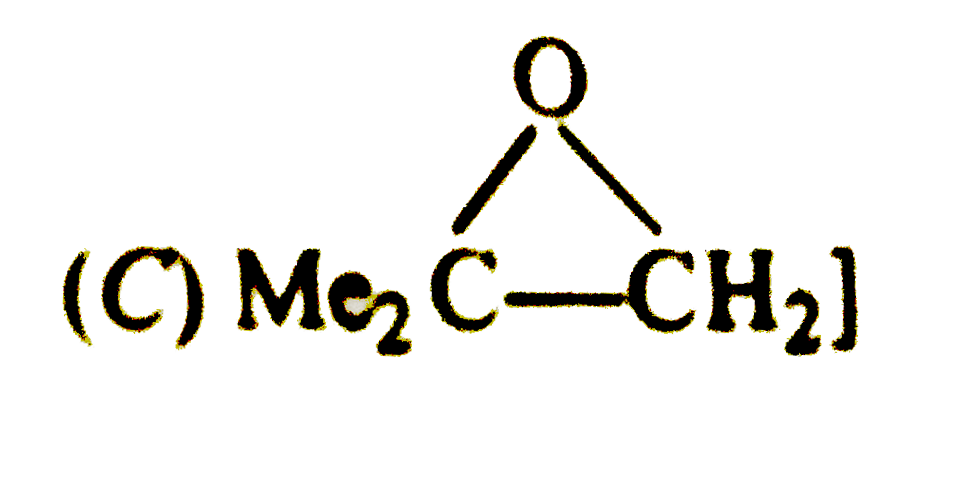(C6H12)HCl−−→B(C6H13Cl)+(C)
(B)Alc.KOH−−−−−→(D) [isomer of (A)]
To solve the problem, we need to analyze the reactions step by step based on the information provided.
Step 1: Identify the starting compound
The starting compound is given as C6H12. This molecular formula indicates that it is an alkene, specifically a hexene, since it follows the general formula for alkenes CnH2n.
Step 2: Determine the structure of the alkene
The simplest structure for hexene can be represented as:
- 1-Hexene: CH2=CH−CH2−CH2−CH2−CH3
- 2-Hexene: CH3−CH=CH−CH2−CH2−CH3
- 3-Hexene: CH3−CH2−CH=CH−CH2−CH3
For this problem, we can assume we are dealing with 1-hexene for simplicity.
Step 3: Reaction with HCl
When C6H12 (1-hexene) reacts with HCl, it follows Markovnikov's rule, where the hydrogen atom from HCl attaches to the carbon with the greater number of hydrogen atoms. This results in the formation of 2-chlorohexane as the major product (B):
- Major product (B): CH3−CHCl−CH2−CH2−CH2−CH3 (2-chlorohexane)
- Minor product (C): CH3−CH2−CH2−CH2−CHCl−CH3 (3-chlorohexane)
Step 4: Reaction of product B with alcoholic KOH
Product B (2-chlorohexane) reacts with alcoholic KOH, which promotes elimination (dehydrohalogenation) to form an alkene. The elimination will occur at the β-hydrogen, leading to the formation of 2-hexene (D):
- Product D: CH3−CH=CH−CH2−CH2−CH3 (2-hexene)
Step 5: Identify the isomer relationship
Both product A (1-hexene) and product D (2-hexene) are isomers of each other, as they have the same molecular formula C6H12 but differ in the position of the double bond.
Final Summary of Products
- A: 1-Hexene (C6H12)
- B: 2-Chlorohexane (C6H13Cl)
- C: 3-Chlorohexane (C6H13Cl)
- D: 2-Hexene (C6H12)
The starting compound is given as C6H12. This molecular formula indicates that it is an alkene, specifically a hexene, since it follows the general formula for alkenes CnH2n.
The simplest structure for hexene can be represented as:
- 1-Hexene: CH2=CH−CH2−CH2−CH2−CH3
- 2-Hexene: CH3−CH=CH−CH2−CH2−CH3
- 3-Hexene: CH3−CH2−CH=CH−CH2−CH3
When C6H12 (1-hexene) reacts with HCl, it follows Markovnikov's rule, where the hydrogen atom from HCl attaches to the carbon with the greater number of hydrogen atoms. This results in the formation of 2-chlorohexane as the major product (B):
- Major product (B): CH3−CHCl−CH2−CH2−CH2−CH3 (2-chlorohexane)
- Minor product (C): CH3−CH2−CH2−CH2−CHCl−CH3 (3-chlorohexane)
Product B (2-chlorohexane) reacts with alcoholic KOH, which promotes elimination (dehydrohalogenation) to form an alkene. The elimination will occur at the β-hydrogen, leading to the formation of 2-hexene (D):
- Product D: CH3−CH=CH−CH2−CH2−CH3 (2-hexene)
Both product A (1-hexene) and product D (2-hexene) are isomers of each other, as they have the same molecular formula C6H12 but differ in the position of the double bond.
- A: 1-Hexene (C6H12)
- B: 2-Chlorohexane (C6H13Cl)
- C: 3-Chlorohexane (C6H13Cl)
- D: 2-Hexene (C6H12)
Topper's Solved these Questions
- BOOK - CENGAGE CHEMISTRY ENGLISHCHAPTER - ALIPHATIC AND AROMATIC ALDEHYDES AND KETONESEXERCISE - Archives Linked Comprehension6videos
ALIPHATIC AND AROMATIC ALDEHYDES AND KETONES
- BOOK - CENGAGE CHEMISTRY ENGLISHCHAPTER - ALCOHOL,PHENOL AND ETHERSEXERCISE - Archives Analytical And Descriptive15videos
ALCOHOL,PHENOL AND ETHERS
- BOOK - CENGAGE CHEMISTRY ENGLISHCHAPTER - APPENDIX INORGANIC VOLUME 2EXERCISE - Short Answer Type179videos
APPENDIX INORGANIC VOLUME 2
Similar Questions
A(C6H12)HCl−−→B+C(C6H13C)
BalcKOH−−−−→D (isomer of A)
Dozonolysis−−−−−→E (it gives negative test with Fehling solution but responds to iodoform test).
Aozolysis−−−→F+G (Both give positive Tollen's but do not give iodoform test)
F+Gconc. NaOH−−−−−−→ HCOONa +a primary alcohol
Identify to A to GView SolutionComplete the following reaction:
o−HOOC(A)−C6H4−CH2−PhSOCl2−−−→(B)
Anhyd−−−−−−−−−→AlCl3,CH3Cl(C)Zn+Hg−−−−−−−→+HCl(D)View Solution
Knowledge Check
- Question 1 - Select One
Supply structural formulae for missing compounds.
(i) H2C=CH2+(A)→ClCH2−CH2OHH2SO4−−−−−−→413K(B)alc. KOH−−−−−−−→Δ(C)
(ii) CH3CHBrCH3alc. KOH−−−−→(A)HBr−−−−−→Peroxide(B)CH3ONa−−−−−→(C)
(iii) Me3CBralc. KOH−−−−→(A)HOCl−−−→(B)NaOH−−−→(C)
 AABCCH3CH=CH2CH3CH(Br)CH2BrCH3CH(OH)CH3BABCCH3CH=CH2CH3CH2CH2BrCH3CH2OCH2CH2CABCCH2CH=CH3CH3CH(Br)CH3CH3CH2OCH2CH2DABCCH2CH=CH3CH3CH2CH2BrCH2CH2CH2OCH3
AABCCH3CH=CH2CH3CH(Br)CH2BrCH3CH(OH)CH3BABCCH3CH=CH2CH3CH2CH2BrCH3CH2OCH2CH2CABCCH2CH=CH3CH3CH(Br)CH3CH3CH2OCH2CH2DABCCH2CH=CH3CH3CH2CH2BrCH2CH2CH2OCH3 - Question 2 - Select One
 Br2−−→CCl4(i)alc. KOH−−−−−−−→(ii)NaNH2(A)major, Product (A) is :AH2C=CH−CH=CH2BCH3−C≡C−CH3CCH3−CH2−C≡CHDCH3−CH=C=CH2
Br2−−→CCl4(i)alc. KOH−−−−−−−→(ii)NaNH2(A)major, Product (A) is :AH2C=CH−CH=CH2BCH3−C≡C−CH3CCH3−CH2−C≡CHDCH3−CH=C=CH2 - Question 3 - Select One
From the following sequence of reactions,
[A] (C6H12)HCl−−→(B)(C6H13Cl)+(C)(C6H13Cl) react with AgNO3 to give white ppt.
[B] Alc.KOH−−−−−→ (D) (An isomer of A) gives positive test with Br2/CCl4
[D] Ozonolysis−−−−−→ (E) gives positive iodoform test and negative Fehling's test .
[A] Ozonolysis−−−−−→(F)+(G) both F and G give positive Tollen's test.
[F]+[G]Conc.NaOH−−−−−−−−→ΔHCOONa+alcohol
The structure A and B respectively are :A B
B C
C D
D
In the following identify the compounds/reaction conditions represented by the alphabets (A),(B), and (C) :
C6H5COOHPCl5−−→(A)NH3→(B)P2O5−−−→C6H5CNH2/Ni−−−−→(C).View SolutionIn the following sequence of reactions,
CH3CH2CH2BrKOH(Alc)−−−−−−→ (A) HBr−−→ (B) KOH(aq)−−−−−→ (C ) The product (C) isView SolutionFrom the following sequence of reactions,
[A] (C6H12)HCl−−→(B)(C6H13Cl)+(C)(C6H13Cl) react with AgNO3 to give white ppt.
[B] Alc.KOH−−−−−→ (D) (An isomer of A) gives positive test with Br2/CCl4
[D] Ozonolysis−−−−−→ (E) gives positive iodoform test and negative Fehling's test .
[A] Ozonolysis−−−−−→(F)+(G) both F and G give positive Tollen's test.
[F]+[G]Conc.NaOH−−−−−−−−→ΔHCOONa+alcohol
The structure of compound D is :View SolutionFrom the following sequence of reactions,
[A] (C6H12)HCl−−→(B)(C6H13Cl)+(C)(C6H13Cl) react with AgNO3 to give white ppt.
[B] Alc.KOH−−−−−→ (D) (An isomer of A) gives positive test with Br2/CCl4
[D] Ozonolysis−−−−−→ (E) gives positive iodoform test and negative Fehling's test .
[A] Ozonolysis−−−−−→(F)+(G) both F and G give positive Tollen's test.
[F]+[G]Conc.NaOH−−−−−−−−→ΔHCOONa+alcohol
The structure of C is :View SolutionFrom the following sequence of reactions,
[A] (C6H12)HCl−−→(B)(C6H13Cl)+(C)(C6H13Cl) react with AgNO3 to give white ppt.
[B] Alc.KOH−−−−−→ (D) (An isomer of A) gives positive test with Br2/CCl4
[D] Ozonolysis−−−−−→ (E) gives positive iodoform test and negative Fehling's test .
[A] Ozonolysis−−−−−→(F)+(G) both F and G give positive Tollen's test.
[F]+[G]Conc.NaOH−−−−−−−−→ΔHCOONa+alcohol
The reaction involve in the F and G with the NaOH is :View Solution
